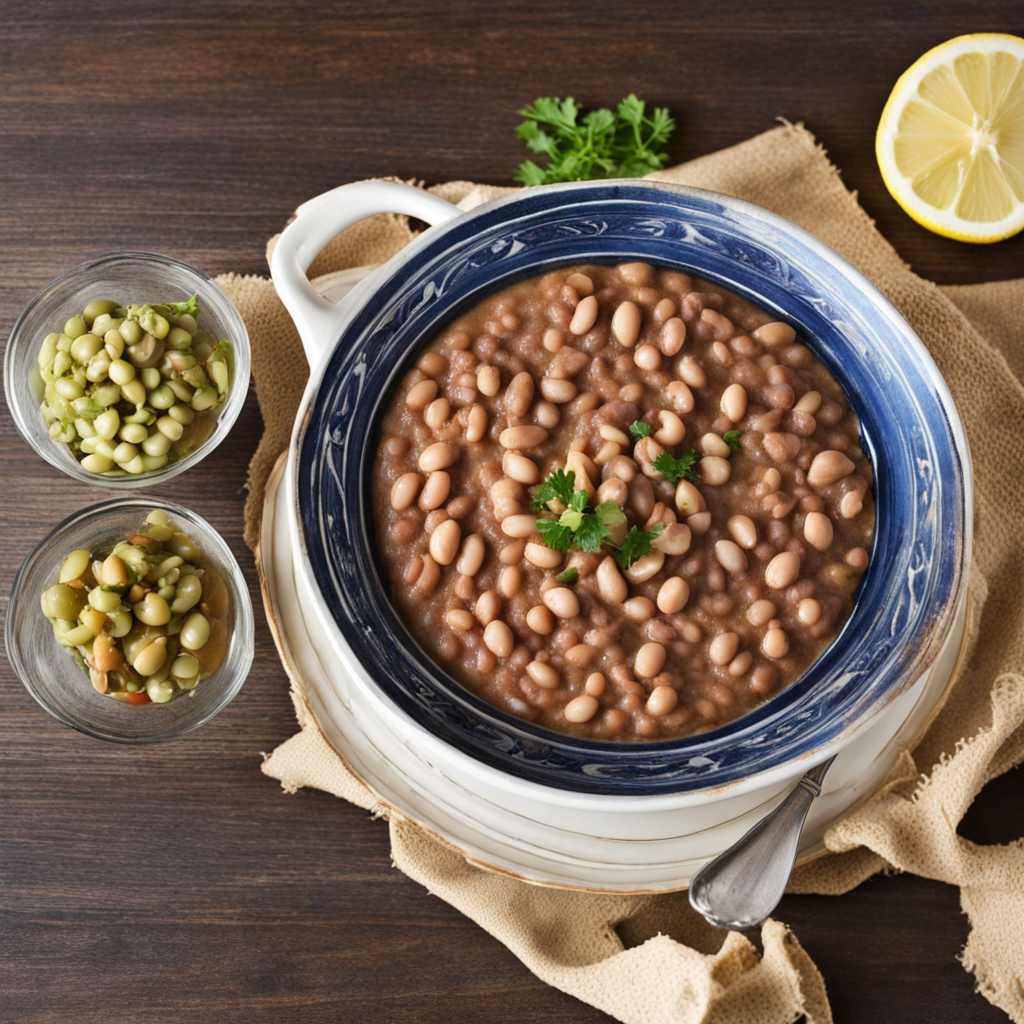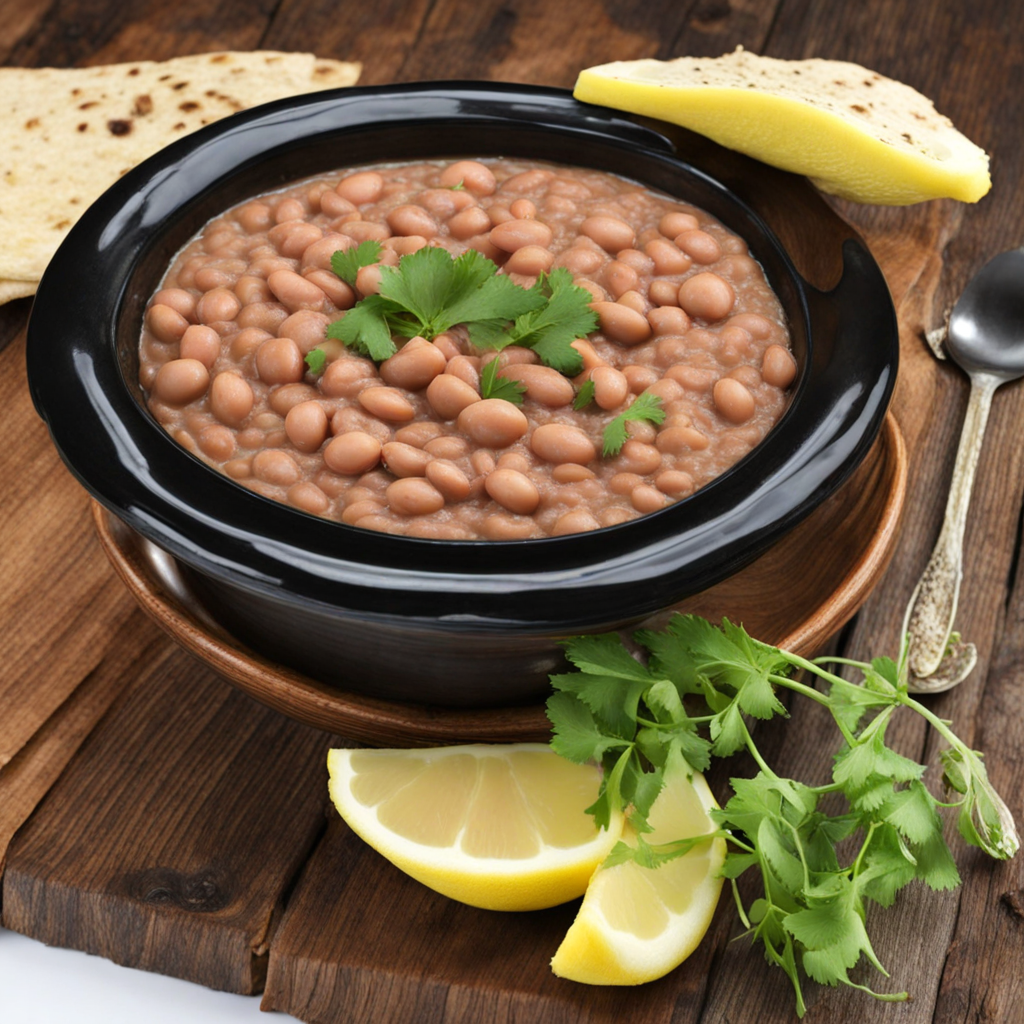Ful Medames
Ful Medames is a traditional Egyptian dish that revolves around fava beans, cooked slowly to achieve a creamy and tender texture. The beans are typically simmered with a mix of spices, garlic, and lemon juice, creating a rich and flavorful base. This humble dish is often enjoyed as a hearty breakfast but can be savored at any time of the day, making it a versatile staple in Egyptian cuisine. The bright acidity of the lemon combined with the earthy flavors of the beans creates a delightful balance that is both comforting and invigorating. One of the most appealing aspects of Ful Medames is its adaptability. While the core ingredients remain the same, regional variations and personal touches often see the addition of toppings like olive oil, chopped tomatoes, onion, parsley, or even a drizzle of tahini. These accompaniments not only enhance the dish’s flavor profile but also add a touch of freshness and texture, making each serving uniquely delightful. The dish is typically served warm with fresh pita bread on the side, perfect for scooping up the luscious beans and toppings. Ful Medames is not just a treat for the taste buds; it's also a nutritious option packed with protein, fiber, and essential vitamins. The simplicity of the ingredients allows the natural flavors of the fava beans to shine through, while the various add-ins provide an opportunity to customize the dish according to personal preferences. Whether you enjoy it plain or fully loaded, Ful Medames is an inviting dish that offers a genuine taste of Egyptian culture and culinary heritage.
How It Became This Dish
The Journey of فول مدمس (Foul Medames): A Culinary Icon of Egypt #### Origins: A Legacy of Ancient Nutrition Foul Medames, pronounced as "fool medames," is a beloved Egyptian dish that has crossed the boundaries of time and geography, evolving into a staple not only in Egypt but throughout the Middle East and North Africa. The dish consists primarily of fava beans, which are slow-cooked and typically served with a variety of garnishes, including olive oil, lemon juice, garlic, and spices. The origins of Foul Medames can be traced back to ancient Egypt, where fava beans were cultivated as early as 4,000 B.C. Archaeological findings suggest that beans were a significant part of the Egyptian diet, revered for their nutritional value and ability to sustain people in the harsh desert climate. Fava beans, known as "broad beans" in some parts of the world, are rich in protein, fiber, and essential vitamins, making them an ideal food source for both the poor and the wealthy. Historically, fava beans were associated with the common people, as they were inexpensive and easy to grow. Ancient texts reveal that they were consumed not only in meals but also offered to the gods during religious ceremonies. This connection to spirituality and sustenance underscores the significance of fava beans in ancient Egyptian culture. #### Cultural Significance: A Meal for the Masses Foul Medames holds a special place in Egyptian cuisine, often regarded as a national dish. It is typically consumed for breakfast, although it can be enjoyed at any time of day. This dish transcends social classes; it is enjoyed by the wealthy and the working class alike, making it a unifying element in Egyptian society. Street vendors serve it in bustling markets, while families prepare it in their homes, showcasing its versatility and accessibility. The preparation of Foul Medames is often a communal activity. Traditionally, families gather around a pot of simmering fava beans, each member contributing their favorite toppings and flavors. This communal aspect of Foul Medames fosters a sense of togetherness and connection, reflecting the broader cultural values of hospitality and sharing in Egyptian society. Moreover, the dish has become a symbol of Egyptian identity, especially in the context of globalization and cultural exchange. As Egyptians migrated, they brought Foul Medames with them, introducing this signature dish to new audiences. It is now a common breakfast item in various Middle Eastern countries, with regional adaptations that reflect local tastes and ingredients. #### Development Through Time: From Ancient Roots to Modern Variations As time progressed, Foul Medames underwent several transformations. In medieval times, the dish evolved to incorporate more complex flavors and garnishing techniques. The introduction of spices such as cumin and coriander, along with the infusion of garlic and lemon, added depth to the dish, enhancing its appeal. In the 19th and 20th centuries, Foul Medames became increasingly popular as Egypt underwent significant social and economic changes. The rise of street food culture in Cairo contributed to its proliferation. Vendors would set up stalls, serving hot bowls of Foul Medames to busy workers and families, solidifying its status as a quintessential Egyptian street food. The dish also began to attract attention from food enthusiasts worldwide, particularly during the 20th century, as travelers and expatriates sought authentic culinary experiences. This exposure led to a broader appreciation of Egyptian cuisine, with Foul Medames often featured in international food festivals and culinary events. In contemporary times, Foul Medames has maintained its traditional essence while also adapting to modern dietary preferences. Vegetarianism and veganism have gained traction globally, and Foul Medames, being plant-based, has found a new audience among health-conscious eaters. Various restaurants, both in Egypt and abroad, have begun to innovate with the dish, offering gourmet versions that incorporate exotic spices, gourmet olive oils, or unique toppings such as avocado or tahini. #### Foul Medames in the Global Context The global popularity of Foul Medames reflects a broader trend in the appreciation of Middle Eastern cuisine. As awareness of healthy eating increases, dishes like Foul Medames are being recognized for their nutritional benefits. The combination of protein-rich fava beans, healthy fats from olive oil, and fresh vegetables makes it a nutritious option that fits well within a balanced diet. Moreover, Foul Medames has found its way onto the menus of trendy cafes and restaurants in cities around the world, often rebranded or presented in fusion styles. This cross-cultural exchange not only highlights the adaptability of the dish but also serves as a reminder of the interconnectedness of global culinary traditions. In regions far removed from Egypt, Foul Medames has emerged as a symbol of Middle Eastern culture, often featured alongside dishes like hummus and falafel. Its increasing presence in international food scenes speaks to the growing interest in authentic, diverse culinary experiences. #### Conclusion: A Dish Beyond Time Foul Medames is more than just a dish; it is a narrative woven into the fabric of Egyptian history, culture, and identity. From its ancient roots to its modern interpretations, Foul Medames represents resilience, adaptability, and the communal essence of food. Its ability to bring people together—whether around a dining table or a bustling street corner—ensures that it will continue to be cherished for generations to come. As food lovers explore the rich tapestry of global cuisine, Foul Medames stands out as a testament to the enduring power of simple ingredients transformed through tradition and innovation. Whether enjoyed in a Cairo café or a trendy eatery in New York, Foul Medames invites everyone to partake in its rich history and cultural significance, making it a true culinary icon of Egypt.
You may like
Discover local flavors from Egypt







